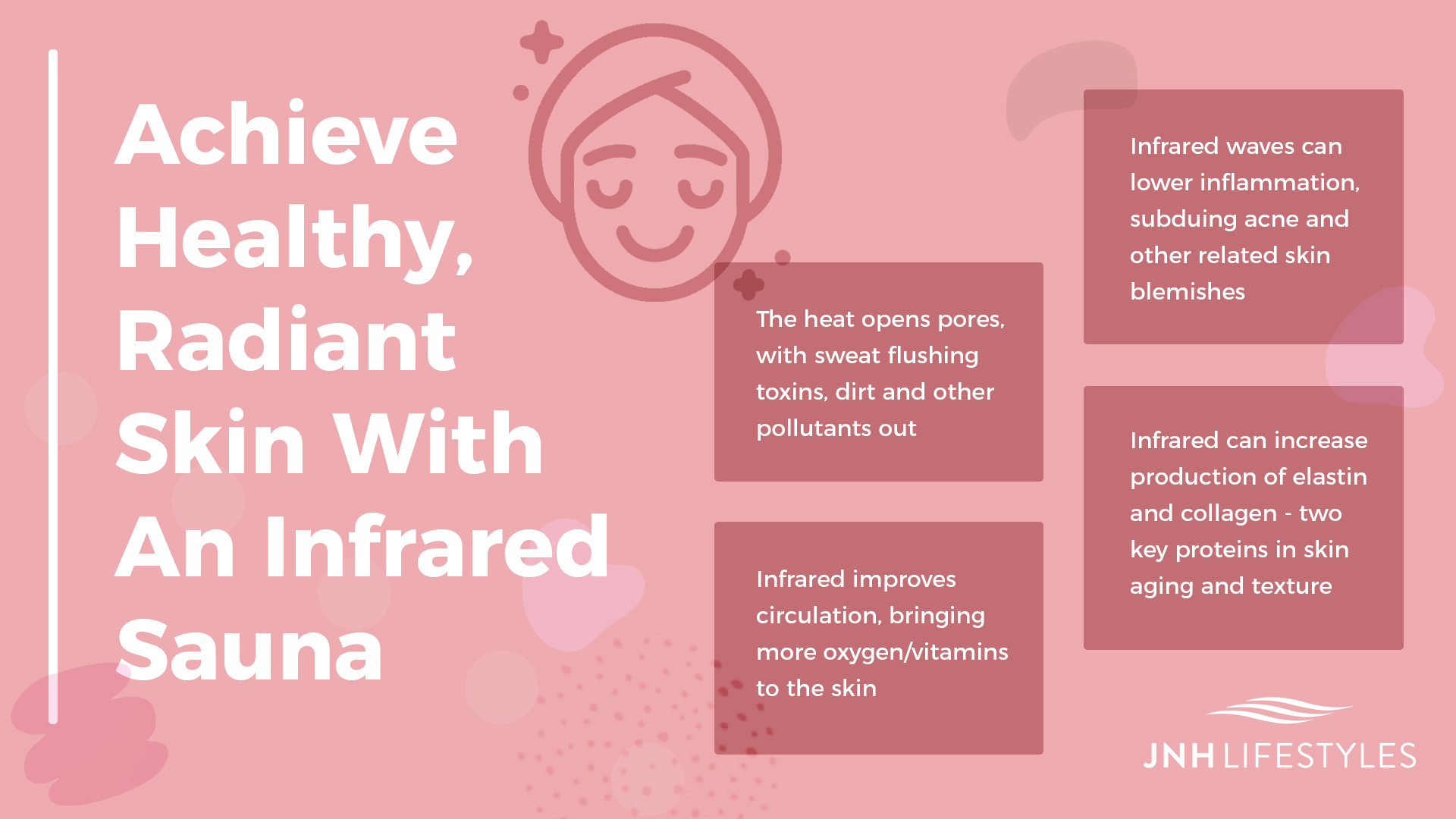Healthy, Clear Skin: Why Infrared Saunas Should Become a Part of Your Skincare Routine
Infrared saunas are one of the growing wellness trends right now. Their health benefits are documented across numerous studies and in practical use. They can boost healing, lessen inflammation, and improve the state of your cardiovascular system [1]. If you pair infrared sessions with exercise, you can build the ultimate and easy-to-follow weight-loss plan [2].
Today, people are installing infrared saunas in their homes, eager to experience all the benefits that these devices can bring. Although infrared waves warms up the body from the inside, the positive effects can also be visible on the outside. Healthy and clear skin can be one of the gains of regularly using infrared therapy. Rejuvenation, radiance and cleansing are only some of the things you may experience by spending time inside an infrared sauna. Take a look at why infrared saunas should become part of your skincare routine.
Why Is Skin Important?
Skin is the first line of defense when pollutants, microbes and toxins attack the body. Since these are things humans are exposed to daily, skin's work is never over. Another important role of the skin is protection against harmful UV radiation that can damage the cells and organs. On a side note, 20 minutes under the sun can allow the skin to produce vitamin D, an important factor for many bodily functions. Thanks to the tiny receptors on the skin, people may feel cold, hot and pain, among many other sensations.
Additionally, skin can have one more crucial role in human lives — the psychological impact. Certain skin conditions, like acne, rosacea, psoriasis and eczema can affect a person’s self-esteem and confidence [3]. As the most noticeable part of the body, this sort of psychological effect is expected. In recent years, a special field called psychodermatology has been established, primarily in Europe, to address this problem more professionally and efficiently. Based on all this, not only can skin be a valuable resource for physical health, but also an essential part of improving the mental state.
Things That Affect Your Skin

Two types of things affect the skin — positive and negative factors. Most of the time, they can be obvious and apparent, but there are circumstances that are out of your hands. For example, life in the city means that your skin is exposed to pollution, viruses and bacteria from numerous people, and stress — an unavoidable part of urban living. While this isn't something you can necessarily change to a great extent, you can manage these issues with positive factors, like proper skincare.
Another factor that determines your skin quality is your genes.Hereditary characteristics of your skin are like a lottery — they can be good or bad, depending on your ancestors. For example, if your mother or father have healthy skin, it may be likely that you will as well. On the other hand, psoriasis and acne are conditions you can inherit from your parents and can greatly affect the way you feel about yourself.
Let's also not forget how harmful the sun is. UV radiation not only causes burns, but can cause premature aging of the skin, hyperpigmentation, and even cancer. You will often hear dermatologists stress the utmost importance of wearing sunscreen even during winter and on a cloudy day. This is because UV rays are highly penetrative and can negatively affect your body, causing cellular mutations and DNA damage [4].
Skincare And Infrared Saunas
Spending time in an infrared sauna can help you maintain healthy skin or keep some of the issues under control. When inside an infrared sauna cabin, the heat makes your pores open, with sweat flushing the toxins, dirt and pollutants out. This can help you have acne-free skin and remove the causes of your inflammation. Also, open pores enhance the absorption of your lotions and creams, allowing more nutrients to reach the deepest parts.
Since infrared sessions can improve your circulation and bring more oxygen and vitamins to your skin, you will have a radiant and rejuvenated complexion. Infrared waves can increase the production of elastin and collagen — two key proteins in skin aging and texture [5]. They can improve the skin’s tone, smoothness and elasticity, as well as lessen hyperpigmentation [6].
When it comes to psoriasis and eczema, infrared therapy is far from being a cure. Because of its healing and anti-inflammatory properties, regular infrared sessions can lessen the symptoms. Since near infrared light concentrates deeply into the skin, it can stimulate cells to create more energy and stimulate self-repair [7]. Infrared saunas are by no means a cure-all, but when used in conjunction with your skincare routine, the right diet and a healthy lifestyle, you're setting your skin up for significantly less breakouts.
Lastly
In this time of excessive environmental pollution, emerging diseases and a hectic way of life, we need to take care of our health in the best possible way. Although skincare is often wrongly believed to be purely aesthetic, it can lead to better physical and mental health. Infrared saunas can be a relevant source of preserving overall health at an optimal level, which can enhance your quality of life.

Resources:
[1] Beever Richard. (2009). “Far-infrared saunas for treatment of cardiovascular risk factors.” ncbi.nlm.nih.gov, National Center for Biotechnology Information, July 2009, https://www.ncbi.nlm.nih.gov/pmc/articles/PMC2718593/.
[2] Kim, Sungwoon, et al. (2017). “Does treadmill walking with near-infrared light applied to the abdominal area reduce local adiposity and body weight?” ncbi.nlm.nih.gov, National Center for Biotechnology Information, October 2017, https://www.ncbi.nlm.nih.gov/pmc/articles/PMC5684004/.
[3] Tuckman, Ari. (2017). “The Potential Psychological Impact of Skin Conditions.” ncbi.nlm.nih.gov, National Center for Biotechnology Information, January 2017, https://www.ncbi.nlm.nih.gov/pmc/articles/PMC5289120/.
[4] Brozyna, A. (2007). “Mechanism of UV-related carcinogenesis and its contribution to nevi/melanoma.” ncbi.nlm.nih.gov, National Center for Biotechnology Information, 2007, https://www.ncbi.nlm.nih.gov/pmc/articles/PMC2564815/.
[5] Wunsch, A and Matuschka, K. (2014). “A Controlled Trial to Determine the Efficacy of Red and Near-Infrared Light Treatment in Patient Satisfaction, Reduction of Fine Lines, Wrinkles, Skin Roughness, and Intradermal Collagen Density Increase.” ncbi.nlm.nih.gov, National Center for Biotechnology Information, February 2014, https://www.ncbi.nlm.nih.gov/pmc/articles/PMC3926176/.
[6] Lee, JH, et al. (2006). “Effects of Infrared Radiation on Skin Photo-Aging and Pigmentation.” ncbi.nlm.nih.gov, National Center for Biotechnology Information, August 2006, https://www.ncbi.nlm.nih.gov/pmc/articles/PMC2687728/.
[7] Zhang, P, and Wu, MX. (2017). “A clinical review of phototherapy for psoriasis.” ncbi.nlm.nih.gov,National Center for Biotechnology Information, October 2017, https://www.ncbi.nlm.nih.gov/pmc/articles/PMC5756569/.

